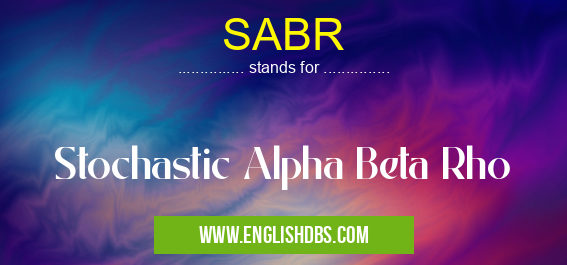What does SABR mean in UNCLASSIFIED
SABR stands for Stochastic Alpha Beta Rho. It's a stochastic volatility model commonly used in financial mathematics to model the volatility of asset prices. Developed by Hagan, Kumar, Lesniewski and Woodward in 2002, SABR is widely employed in the pricing of interest rate derivatives and equity options.

SABR meaning in Unclassified in Miscellaneous
SABR mostly used in an acronym Unclassified in Category Miscellaneous that means Stochastic Alpha Beta Rho
Shorthand: SABR,
Full Form: Stochastic Alpha Beta Rho
For more information of "Stochastic Alpha Beta Rho", see the section below.
Key Components of SABR
- Alpha (α): Represents the initial volatility at time zero.
- Beta (β): Characterizes the mean reversion of volatility to its long-term average.
- Rho (ρ): Quantifies the correlation between the asset price and its volatility.
How SABR Works
The SABR model assumes that the volatility of an asset price follows a stochastic process, meaning it varies randomly over time. The model's parameters determine the behavior of this volatility process. Alpha represents the current volatility level, beta describes how quickly volatility reverts to its long-term average, and rho measures the degree of correlation between price and volatility.
Applications of SABR
SABR is extensively used in the pricing and hedging of financial instruments that are sensitive to volatility. Some common applications include:
- Interest rate derivatives: Pricing interest rate swaps, caps, and floors.
- Equity options: Valuing call and put options on stocks and indices.
- Commodity derivatives: Pricing options and futures contracts on commodities like oil and gas.
Advantages of SABR
- Flexibility: SABR can capture a wide range of volatility patterns, making it suitable for modeling various asset classes.
- Parsimonious: Despite its complexity, SABR has relatively few parameters, simplifying its calibration.
- Market acceptance: SABR is widely used by financial institutions, enhancing its liquidity and market depth.
Essential Questions and Answers on Stochastic Alpha Beta Rho in "MISCELLANEOUS»UNFILED"
What is SABR?
Stochastic Alpha Beta Rho (SABR) is a stochastic volatility model widely used in finance to model the volatility of asset prices. It is a one-factor model, meaning it assumes that the volatility of an asset is driven by a single underlying stochastic process.
What are the parameters of the SABR model?
The SABR model has four parameters: alpha, beta, rho, and nu. Alpha represents the initial volatility of the asset, beta measures the elasticity of volatility to the underlying asset price, rho captures the correlation between the asset price and its volatility, and nu controls the shape of the volatility curve.
How is the SABR model used in practice?
The SABR model is commonly employed in option pricing, risk management, and portfolio optimization. It is particularly useful for modeling the volatility of assets with a volatility smile or skew, which are common features of equity and currency markets.
What are the advantages of using the SABR model?
The SABR model has several advantages:
- It captures the volatility smile or skew observed in many asset markets.
- It is relatively simple to calibrate and implement.
- It is computationally efficient, making it suitable for large-scale applications.
Are there any limitations to the SABR model?
While the SABR model is widely used, it has some limitations:
- It assumes that volatility is driven by only one factor, which may not be true in all cases.
- It can struggle to capture the volatility of assets that exhibit extreme price movements.
- It does not account for jumps or other discontinuities in the asset price process.
Final Words: SABR is a powerful stochastic volatility model that provides a flexible and accurate framework for modeling the dynamics of asset price volatility. Its applications extend to a wide range of financial instruments, making it an essential tool for practitioners in the derivatives markets.
